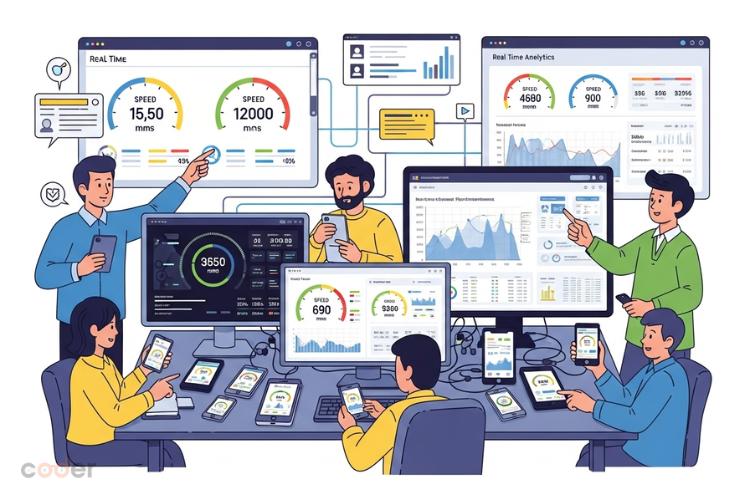
In the current virtual world, mobile apps have become a crucial part of our daily activities, delivering productivity and convenience. The popularity of a mobile app depends upon its performance, ease of use & compatibility. However, deploying an application without testing on a mobile device can have severe negative effects on both users and the business. Slow & badly tested applications can damage the brand’s reputation.
Nowadays, customers hold high expectations for the efficiency and speed of any app. Failure to match the expectations can lead to bad testimonials and loss of trust, and destroy brand identity. Underperforming applications can make a more significant impact on your business. As per the market reports, the average cost of downtime accumulates 5,600/minute. 87% of IT businesses stated that mobile app performance is necessary for the enterprises.
90% of organizations stated that poor mobile app quality costs their organizations up to $2.49M. Performance testing services should be a part of every mobile development service. Performance testing is the quantitative & qualitative approach to test the speed & effectiveness of any app. In the content below, we have discussed the risks of skipping mobile performance testing.
Table of Contents
I. What is Mobile Performance Testing?
1. Definition and Purpose

The smartphone technology delivers high-definition touch screens, internet access & GPS capabilities, etc. Based on Statista, the huge amount of mobile devices is expected to surpass 311 million by 2025. The industry has been frequently embracing virtual transformation to offer an improved user experience. According to the current state, the dependency on digital channels has been huge, making every business push to design & develop mobile apps.
However, throughout the SDLC, ignoring web app performance testing can lead to loss of ROI and limited sales. Investing in web app performance testing services is a powerful measure to protect the organization’s finances. Performance testing is necessary to maintain the brand reputation by ensuring a quality user experience. Performance testing verifies that the app is working best under stress conditions. The testing focuses on areas like speed, stability, responsiveness & scalability.
Mobile testing by a performance testing company is the method of measuring mobile apps to ensure they meet specific quality standards & functions as measured. It includes a systematic assessment of various aspects of an app, involving its security, compatibility, and functionality. The mobile performance testing helps to detect & resolve the vulnerabilities that could potentially damage the user experience.
With a vast range of applications available, ensure mobile testing becomes paramount to maintain user satisfaction. As per statistics, 66% of users uninstall the app when they find any error in it. So, overall, to minimize the app crashes & offer a smooth user journey, Mobile performance testing is a must.
2. Types of Mobile Performance Tests
Load testing
A non-functional kind of testing called load testing services determines whether the program can manage the anticipated demand. Therefore, load, volume, capacity, stress, and many other characteristics are tested anytime an application is tested for performance. By examining the visual records, charts, and video recordings of different test runs, load testing plays a crucial role in the mobile development lifecycle by assisting in the construction of robust and dependable systems.
With load testing, we can determine the mobile application’s capacity long before it launches. Load testing evaluates the API’s performance against heavy loads. This entails assessing the performance of your mobile application and backend APIs under typical and high user loads.
Stress testing
Pushing your application and backend APIs past their typical operating limits in order to identify their breaking points is the main goal of stress testing. By replicating excessive user interaction or resource limitations, such as little memory, a bad network, or high CPU utilization, it goes beyond typical load testing and observes how the application reacts. Observing how the app and services malfunction in harsh circumstances is intended to shed light on how reliable and stable they are.
Endurance testing
A type of performance testing called endurance testing, sometimes referred to as soak testing, evaluates a system’s ability to function under extended stress. This means overloading your system and keeping an eye out for any slowdowns or breakdowns. It enables you to make sure that actual users can access this without finding any issues.
Endurance testing mimics the simultaneous interaction of hundreds or even thousands of users with your system. The test is run for a predetermined period of time. For performance problems like delays, malfunctions, and transaction failures, the system is constantly monitored. Before the technology is made accessible to actual users, any problems found during testing are resolved.
Spike testing
Spike testing is a kind of performance testing that evaluates how responsive and resilient a system is to sudden, large shifts in user activity. In order to observe how the system responds to a sudden and substantial boost in concurrent users, transactions, or data volume, spike testing involves overloading the system.
This testing ensures that the most important features continue to be available and responsive during peak hours, finds performance bottlenecks, and gauges system stability. The goal of spike testing is to make sure the system can withstand unexpected spikes in load and bounce back when the load returns to normal.
Network performance testing
Mobile applications must be tested in a variety of scenarios, such as 4G, 5G, Wi-Fi, and inadequate network support, because they are closely linked to network connectivity. Mobile apps depend on network connectivity to offer practical features. Network testing includes running network simulation tests based on mobile networks for bandwidth difficulties in order to find connectivity issues and bottlenecks, and then investigating their effects on application performance. Testers must make sure the mobile application can easily handle network transitions and operate at its best over a range of network speeds.
II. Why Some Businesses Skip Mobile Performance Testing?

1. Common Reasons
Tight deadlines and budget constraints
Businesses frequently underestimate the significance of mobile load and performance testing services until serious problems develop due to tight deadlines and financial restrictions. This choice may eventually result in significantly increased cost and damage to brand reputation.
Misunderstanding its importance
Due to misconceptions and incorrect presumptions about its significance, several companies neglect mobile performance testing, which can have detrimental effects, including lost sales and a tarnished reputation. Instead of seeing performance testing as an essential requirement for success in a cutthroat market, many businesses see it as an expensive and time-consuming choice.
Overreliance on functional testing
While neglecting functional software performance testing services may end in a system that functions well but falls short of the desired business objectives, neglecting performance testing can cause obstacles that functional testing will miss.
Belief that issues can be fixed after launch
Due to a number of operational and strategic considerations, businesses may think that problems may be resolved after launch. With this belief, they skip application performance testing services, but later, it affects their business badly.
2. The False Economy
Skipping software testing could result in instant savings, but these are frequently deceptive. The initial cost savings are soon eclipsed by the costs associated with resolving consumer complaints, repairing problems, and mitigating potentially avoidable catastrophes. Big businesses have experienced diminishing market share, financial losses, and, in certain situations, bankruptcy as a result of performance problems.
Nokia was the top producer of mobile phones for many years, but in the end, it was unable to identify the market’s shift towards smartphones and software ecosystems. The significance of the software and app ecosystem made popular by Apple and Google was undervalued by Nokia’s leadership.
The corporation continued to concentrate on its antiquated hardware and operating system, which made its products uncompetitive. In 2013, the company sold its shares to Microsoft. Since then, the business has rebranded itself as a pioneer in 5G technologies and telecoms infrastructure.
III. Business Consequences of Skipping Performance Testing
1. Poor User Experience
Users’ interactions with a site might be significantly impacted by poor UX! For example, Hootsuite has been criticized for its cumbersome dashboard that displays too much information at once, poor loading times, and challenging navigation. Users become frustrated when they can’t easily find tools or complete activities due to an excessive layout.
Positive customer retention depends on a flawless user experience. Software load testing services assist in detecting usability problems that might reduce user pleasure. You can make sure your software is easy to use, clear, and satisfies the needs of your target audience by implementing testing.
2. Revenue Loss
Users are less likely to engage or finish purchases when they have trouble navigating a website or app! Spending per client is frequently lowered by poorly optimized product pages or ambiguous cross-selling tactics. Although the goal of these alerts is to generate a sense of urgency, they frequently overwhelm and stress consumers, which lowers conversions.
Conversion rates can be directly impacted by a slow application, particularly in e-commerce. A few seconds of delay can cause a large decline in revenues. When they encounter delays, irate customers frequently give up on their purchases or transactions. Particularly during high-traffic occasions like product debuts or sales, neglecting performance testing service might lead to a large loss of sales.
3. Brand Damage

The reputation of your company might be seriously harmed by releasing software with flaws. Consumers might stop trusting your goods and services, which would result in lower sales and bad press. It takes a lot of effort and money to repair a damaged reputation. The company’s reputation may suffer if a poorly tested app is released. App performance is linked by users to the general dependability and quality of the brand.
For instance, in an effort to slow the virus’s transmission, the UK government released the NHS COVID-19 contact tracing app in 2021. However, there were serious usability problems and technical difficulties with the app. These issues undermined the app’s functionality in achieving its goals by causing a lack of confidence and adoption.
4. Higher Post-Release Costs
When flaws are found after a product has been released, the cost of neglecting software performance testing services becomes clear. It is far more costly and time-consuming to fix defects after launch than it is to do so during development. Additionally, it may cause delays in other projects and interfere with ongoing operations.
It takes enough resources to find and repair problems following a release. Users were crucially unable to check in for their flights during RyanAir’s website and app outages in 2023. In order to resolve user concerns, fix bugs, and enhance overall app performance, the company had to devote more resources, which resulted in unforeseen expenses.
IV. Real-World Examples & Statistics
Performance problems have caused a number of mobile apps to fail, such as the Uber bug that revealed hookups through slow notifications and Yik Yak, which experienced suspensions and harassment owing to performance problems with its primary anonymous function. An app’s viability and discoverability in app stores are impacted by poor performance, which displays as crashes, slow loading times, and unresponsiveness. These issues directly cause frustration among users and high removal rates.
Probably the greatest method to make successful apps is to learn from other people’s errors. We can learn about the patterns and red flags that lead to dissatisfaction and loss of profit in the mobile app market by examining real-world app failure instances. Over 90% of smartphone apps on the market eventually fail. Within three days of being installed, an average app eliminates 77% of its active users. Here are some more briefs about the apps that failed due to a lack of performance testing.
Google Plus: Perhaps the best illustration of how apps fail in spite of massive resources and support is Google+. In order to compete with Facebook, Google introduced Google+ in 2011. The website had a lot going for it, including unlimited funding, connection with other Google services, and a robust marketing campaign. The main areas of failure were:
- Late arrival in a crowded market
- Integration with other Google services is required
- An interface that was too complicated and confused people
- Not providing a distinctive value proposition
After falling for a number of years, Google Plus was formally ended in 2019. This story illustrates how even major IT companies may have app failures if they disregard customer demands.
The social security theft at Equifax
Equifax, the largest credit reporting business, revealed that hackers had taken up to 143 million customer details. As more information about the attack surfaced, it became evident that a large portion of the harm was caused by Equifax’s extreme incompetence.
V. How to Avoid These Business Risks?
1. Integrate Performance Testing Early

Try to establish clear, quantifiable performance targets as soon as you can, regardless of the measurements or KPIs you use, through throughput, response time, or something else entirely. If you don’t set goals early on, your testing will be somewhat aimless. In addition to requiring early testing, a test-driven strategy also calls for frequent testing. As soon as it is possible to run the earliest development code, testing should start.
The aforementioned dynamic test setup should make it easier and less costly for each subsequent iteration to begin a new round of testing. Clearly state performance goals, such as resource time and throughput requirements. Prioritize areas that need improvement according to predetermined standards, and ensure that these objectives align with business goals.
2. Invest in the Right Tools
For precise insights and efficient software optimization, selecting the appropriate performance testing tools is essential. There are many different tools accessible, each with unique advantages and disadvantages. While enterprise-grade solutions like LoadRunner offer strong support across a variety of protocols and applications, open-source tools like Apache JMeter offer flexibility. Each tool has special advantages that make it appropriate for a variety of testing scenarios, including scalability, CI/CD integration, and developer-centric capabilities. Simulators don’t accurately capture the subtleties of real-world device performance, although they can be helpful for initial testing. The most precise and trustworthy performance data comes from testing on actual devices. This is necessary for smartphone apps, as performance can be greatly impacted by device fragmentation.
3. Collaborate Across Teams
Encourage collaboration across the development, testing, operations, and business teams in order to establish shared performance standards and objectives. Motivate the team for seamless communication & share their approaches so that every member can contribute to the greatest potential application performance.
By encouraging cooperation and open communication across cross-functional performance testing service teams, establishing unified performance goals, and ensuring alignment with corporate goals through shared understanding, organizations can achieve optimal application performance. Ultimately, this collaborative approach results in software solutions that satisfy company needs and user expectations while also encouraging innovation, responsibility, and transparency.
Conclusion
It is impossible to overstate the consequences of releasing a mobile app without conducting enough application performance testing services. The repercussions are extensive, ranging from lost revenue potential and brand damage to user unhappiness and unfavorable reviews. Businesses must understand how crucial thorough testing is to guarantee a flawless user experience, upholding the reputation of their brand, and protecting user data.
Mobile app load and performance testing services are a continuous commitment to producing dependable, safe, and user-friendly apps rather than only a work to be completed before launch. Developers and testers can produce apps that get noticed in an ever-crowded digital market by embracing the latest trends of mobile app testing.











![[SALE OFF] Discount 30% All Premium Extensions On Christmas And New Year 2025 christmas-and-new-year-2025](https://landofcoder.b-cdn.net/wp-content/uploads/2024/12/christmas-and-new-year-2025-1-218x150.png)






